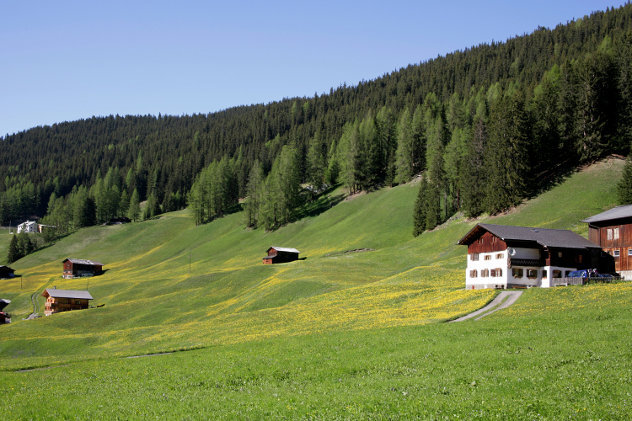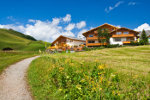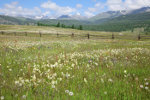Where to buy property in Austria?
Elizabeth Bagwell, Saturday, 25 January 2014

This article is part of a series of 8 articles about buying property in Austria. The other articles in the series cover the following topics:
Austria is a small country on the western edge of eastern Europe. It's primarily German speaking, and bordered by Italy, Switzerland, Germany, the Czech Republic, Slovakia, Hungary and Slovenia. The geography runs from Alps in the west to wide plateaus in the east which are ideal for wine growing and have a similar climate to northern Italy.
The country is divided into 9 provinces, called Bundesländer, and while each has its own character, it's usually more effective, for non-residents, to divide the country by geographical and social features. The country is home to top skiing destinations including St Anton, Ischgl and Kitzbühel as well as major cultural and sporting centres such as Vienna, Salzburg and Innsbruck.
Why buy property in Austria?
Austria is a European member state with a stable economy, low crime rates and a stable political system. It's also a beautiful place to visit in both summer and winter. Despite these attractions, the property market has had low international investment, meaning that prices are typically lower than in comparable regions in France, Italy or Switzerland.
Austrian villages typically have the same charming, traditional atmosphere and great facilities as the Swiss Alpine resorts, and as regulations are less strict they also have greater availability of properties for foreign investment. A few of the most popular and exclusive resorts are beginning to introduce restrictions on foreign investment, but these tend to be the only limitations.
Ski chalets and mountain lodges
Skiing and other winter and summer sports are popular in Austria and draw many tourists. As the country is not as heavily commercialised as France or as expensive as Switzerland, it's a popular destination for investors and holiday makers alike. Each resort has its own characteristics, and the country has a good mix. The residential areas in resorts tend to be in keeping with the traditional charms of the village – you won't see the concrete tower blocks so popular in France.
The ski stations themselves are sometimes distinct from the residential areas, making ski-in, ski-out properties rarer but giving visitors a wider domain within easy reach. World-famous resorts, such as St Anton, are naturally expensive but there are bargains to be found in hidden gems of resorts. As you move further east, the mountain peaks tend to get lower, making the snow somewhat less reliable and the slopes less challenging. However, popular resorts for visitors, particularly families exist throughout the Austrian Alps.
What is the Tyrol?
Although the name has become synonymous, for some, with the high Alps, it actually refers to a particular area of Austria. The Tyrol is probably the most famous of Austria's provinces. It is home to the mountain peaks that are so attractive to skiers and summer visitors. The area has the sort of beauty that Austria and Switzerland are known for, the kind of scenery you imagine when reading Heidi or watching The Sound of Music.
Nowadays, the area is a popular tourist destination with thousands of kilometres of ski pistes. The capital city, Innsbruck, is a charming historical town of just 120,000 people and is a 40 minute tram ride from the Neustift Valley ski stations. Innsbruck is a cultural and sporting centre, which has twice hosted the Olympics and regularly hosts other major competitions, such as Euro 2008.
Property in the cities
Over 40% of Austrian residents rent their accommodation, largely from private landlords, and this is particularly common in the larger cities such as Vienna, Salzburg and Innsbruck. Each of these is also a popular tourist destination. Both vacation rentals and long term tenancies are common and tend to represent a good investment.
Austria's cities are small by global standards. While Vienna has 1.5 million inhabitants, there are only 4 other cities with over 100,000 people, none of which have over 250,000 inhabitants. As a general rule, the city centres retain their historic charm. Apartment buildings in 19th century town houses form the top of the market and are often both well located and extremely attractive. Larger family properties tend to dominate the nearby suburbs, and commuting distances are short.
Vienna
Austria's capital city is famous for its beautiful streets and eminent citizens. Musical talents including Mozart, Beethoven, Haydn and Brahms all worked in the city, as did many other brilliant minds, including, famously, Sigmund Freud. Today, the city is a popular tourist destination and the second largest German speaking city, after Berlin.
While prices are higher in Vienna than the rest of Austria, they are still relatively low compared to other European capitals such as Paris or London. The housing market is strong and stable, making it a popular choice for international investment, both in terms of long term and vacation rentals. Tourists flock to the city which has a pleasant climate and an excellent cultural program.

This article is part of a series of 8 articles about buying property in Austria. The other articles in the series cover the following topics:
Austria is a small country on the western edge of eastern Europe. It's primarily German speaking, and bordered by Italy, Switzerland, Germany, the Czech Republic, Slovakia, Hungary and Slovenia. The geography runs from Alps in the west to wide plateaus in the east which are ideal for wine growing and have a similar climate to northern Italy.
The country is divided into 9 provinces, called Bundesländer, and while each has its own character, it's usually more effective, for non-residents, to divide the country by geographical and social features. The country is home to top skiing destinations including St Anton, Ischgl and Kitzbühel as well as major cultural and sporting centres such as Vienna, Salzburg and Innsbruck.
Why buy property in Austria?
Austria is a European member state with a stable economy, low crime rates and a stable political system. It's also a beautiful place to visit in both summer and winter. Despite these attractions, the property market has had low international investment, meaning that prices are typically lower than in comparable regions in France, Italy or Switzerland.
Austrian villages typically have the same charming, traditional atmosphere and great facilities as the Swiss Alpine resorts, and as regulations are less strict they also have greater availability of properties for foreign investment. A few of the most popular and exclusive resorts are beginning to introduce restrictions on foreign investment, but these tend to be the only limitations.
Ski chalets and mountain lodges
Skiing and other winter and summer sports are popular in Austria and draw many tourists. As the country is not as heavily commercialised as France or as expensive as Switzerland, it's a popular destination for investors and holiday makers alike. Each resort has its own characteristics, and the country has a good mix. The residential areas in resorts tend to be in keeping with the traditional charms of the village – you won't see the concrete tower blocks so popular in France.
The ski stations themselves are sometimes distinct from the residential areas, making ski-in, ski-out properties rarer but giving visitors a wider domain within easy reach. World-famous resorts, such as St Anton, are naturally expensive but there are bargains to be found in hidden gems of resorts. As you move further east, the mountain peaks tend to get lower, making the snow somewhat less reliable and the slopes less challenging. However, popular resorts for visitors, particularly families exist throughout the Austrian Alps.
What is the Tyrol?
Although the name has become synonymous, for some, with the high Alps, it actually refers to a particular area of Austria. The Tyrol is probably the most famous of Austria's provinces. It is home to the mountain peaks that are so attractive to skiers and summer visitors. The area has the sort of beauty that Austria and Switzerland are known for, the kind of scenery you imagine when reading Heidi or watching The Sound of Music.
Nowadays, the area is a popular tourist destination with thousands of kilometres of ski pistes. The capital city, Innsbruck, is a charming historical town of just 120,000 people and is a 40 minute tram ride from the Neustift Valley ski stations. Innsbruck is a cultural and sporting centre, which has twice hosted the Olympics and regularly hosts other major competitions, such as Euro 2008.
Property in the cities
Over 40% of Austrian residents rent their accommodation, largely from private landlords, and this is particularly common in the larger cities such as Vienna, Salzburg and Innsbruck. Each of these is also a popular tourist destination. Both vacation rentals and long term tenancies are common and tend to represent a good investment.
Austria's cities are small by global standards. While Vienna has 1.5 million inhabitants, there are only 4 other cities with over 100,000 people, none of which have over 250,000 inhabitants. As a general rule, the city centres retain their historic charm. Apartment buildings in 19th century town houses form the top of the market and are often both well located and extremely attractive. Larger family properties tend to dominate the nearby suburbs, and commuting distances are short.
Vienna
Austria's capital city is famous for its beautiful streets and eminent citizens. Musical talents including Mozart, Beethoven, Haydn and Brahms all worked in the city, as did many other brilliant minds, including, famously, Sigmund Freud. Today, the city is a popular tourist destination and the second largest German speaking city, after Berlin.
While prices are higher in Vienna than the rest of Austria, they are still relatively low compared to other European capitals such as Paris or London. The housing market is strong and stable, making it a popular choice for international investment, both in terms of long term and vacation rentals. Tourists flock to the city which has a pleasant climate and an excellent cultural program.

On our Dutch website Affidata.com you will find all types of property for sale in Austria by private sellers and estate agents. Find a property in the Austrian Alps, Tyrol, Innsbruck or Vienna.
 Being prepared is half the battle, and that's even more true when dealing with the red tape of a foreign bureaucracy. The following guide describes the
different sets of documents required for each stage of the process of buying a property in Austria and applying for an Austrian mortgage. Read on to
find out more.
Being prepared is half the battle, and that's even more true when dealing with the red tape of a foreign bureaucracy. The following guide describes the
different sets of documents required for each stage of the process of buying a property in Austria and applying for an Austrian mortgage. Read on to
find out more.